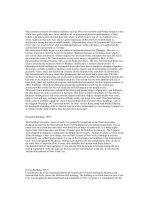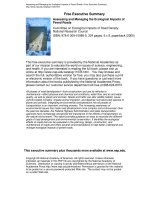- Trang chủ >>
- Khoa Học Tự Nhiên >>
- Vật lý
managing the margins gender citizenship and the international regulation of precarious employment feb 2010
Bạn đang xem bản rút gọn của tài liệu. Xem và tải ngay bản đầy đủ của tài liệu tại đây (2.46 MB, 330 trang )
Managing the Margins
This page intentionally left blank
Managing the Margins
Gender, Citizenship, and the
International Regulation of Precarious
Employment
Leah F. Vosko
1
3
Great Clarendon Street, Oxford OX26DP
Oxford University Press is a department of the University of Oxford.
It furthers the University’s objective of excellence in research, scholarship,
and education by publishing worldwide in
Oxford New York
Auckland Cape Town Dar es Salaam Hong Kong Karachi
Kuala Lumpur Madrid Melbourne Mexico City Nairobi
New Delhi Shanghai Taipei Toronto
With offices in
Argentina Austria Brazil Chile Czech Republic France Greece
Guatemala Hungary Italy Japan Poland Portugal Singapore
South Korea Switzerland Thailand Turkey Ukraine Vietnam
Oxford is a registered trade mark of Oxford University Press
in the UK and in certain other countries
Published in the United States
by Oxford University Press Inc., New York
# Leah F. Vosko 2010
The moral rights of the author have been asserted
Database right Oxford University Press (maker)
First published 2010
All rights reserved. No part of this publication may be reproduced,
stored in a retrieval system, or transmitted, in any form or by any means,
without the prior permission in writing of Oxford University Press,
or as expressly permitted by law, or under terms agreed with the appropriate
reprographics rights organization. Enquiries concerning reproduction
outside the scope of the above should be sent to the Rights Department,
Oxford University Press, at the address above
You must not circulate this book in any other binding or cover
and you must impose the same condition on any acquirer
British Library Cataloguing in Publication Data
Data available
Library of Congress Cataloging in Publication Data
Data available
Typeset by SPI Publisher Services, Pondicherry, India
Printed in Great Britain
on acid-free paper by
MPG Books Group, Bodmin and King’s Lynn
ISBN 978–0–19–957481–0
13579108642
For Gerald
This page intentionally left blank
Acknowledgements
In researching and writing this book, I benefited from the intellectual
engagement of many colleagues, students, policy actors, and community
activists, whose interest in this work has been sustaining.
My first debt is to the organizations providing financial support—the
Canada Research Chairs Program, the Social Sciences and Humanities
Research Council of Canada (standard grant no. 410–2006–2361), the
Canadian Foundation for Innovation, and the Ontario Premier’s Research
Excellence Award program. From my home institution, York University,
I am grateful to the Office of the Vice-President Research and Innovation,
the Faculty of Graduate Studies, and the Atkinson Faculty for providing me
with supports and precious time for research and writing.
As I wrote Managing the Margins, I spent time at a number of dynamic
institutions. At Rutgers University (1998–9), I came to recognize the impor-
tance of gaining a grasp of the history of protective labour legislation for
a study of this kind. Since then, my knowledge has been enhanced by
interactions with historians Dorothy Sue Cobble and Karen Balcom and
from the helpful commentary of Alice Kessler-Harris, who read a segment of
the book at an important moment.
At McMaster University (1999–2001), I benefited from collaborations
with the research group on Workers and Social Cohesion (Robert O’Brien,
Roy Adams, Karen Bird, Belinda Leach, Wayne Lewchuk, Mark Thomas,
Don Wells, and Charlotte Yates) and exchanges with Donna Baines, Robert
Storey, and Robert Wilton.
Before, during, and after I took up a Visiting Research Fellowship at the
Royal Melbourne Institute of Technology in the summer of 2006, Iain
Campbell and Michael Rawling provided terrific feedback on Chapters 4
and 6 respectively. Both scholars also opened their networks to me, leading
to connections with many fine Australian scholars whose insights further
enriched this work—Marian Baird, Sarah Charlesworth, Anne Junor, Jill
Murray, Anthony O’Donnell, Rosemary Owens, Barbara Pocock, Michael
Quinlan, Amanda Tattersall, and Iain Watson.
vii
Writing this book required several extended stays in Geneva, where I
conducted fieldwork at the ILO, spent days in its library, and time with ILO
constituents and office staff. From the ILO, I am indebted, in particular,
to Enrique Marin for sharing his insights with me during long stints ob-
serving negotiations and to Anne Trebilcock for making space for me
institutionally.
I completed the first full draft of Managing the Margins during a sabbatical
at the University of Oxford (2006–7), where I was hosted by the Institute of
Gender Studies, Queen Elizabeth House, and welcomed institutionally by
Maria Jaschok and Barbara Harris-White. In Oxford, I was very fortunate
to have two wonderful colleagues—Linda McDowell and Sue Ledwith—
close at hand and eager to discuss mutual research interests. While in
Britain, I also connected with other scholars from whom I received helpful
feedback, particularly Colin Crouch, who read several chapters of the man-
uscript, as well as Neil Coe, Collette Fagan, Anne McBride, Jacqueline
O’Reilly, Jill Rubery, and Kevin Ward, who invited me to share research
findings at the Universities of Sussex and Manchester.
Colleagues in Canada in the academic and community sectors have
also been tremendously supportive. The encouragement and fe edback
I received from Barbara Cameron and Joan San gster on critical compo-
nents of the manuscript was invaluable, as were the suggestion s of Emily
Andrew, Linda Bris kin, Joseph Carens, Engin Isin, and Miriam Smith, who
helped me sort out where and how to place the book. And then there are
the many colleagues who consistently reminded me that this wo rk mat-
tered: Pat Armstrong, Hugh Armstrong, Isabella Bakker, Kate Bezanso n,
Wallace Clemen t, Deborah Clipperton, M arjorie Cohen, Tania Das Gupta,
Christina Gabriel, Mary Gellatly, Wenona Giles, Marnina Gonick, Gloria
Kim, Fuyuki Kurasawa, Deena Ladd, Brian Langille, Meg Luxton, Martha
MacDonald, Rianne Mahon, Joanne Magee , Stacey Mayhall, Kiran Mirch-
andani, Ann Porter, Laurell Ritchie, Dagmar Soennecken, Neil Smith,
Lynn Spink, Jim Stanford, Sandra Whitworth , Joanne Wright, and Nancy
Zukewich.
As I completed the manuscript, I had the honour of overseeing a talented
team of researchers in a Community-University Research Alliance on
Precarious Employment in Canada. I am grateful to all alliance members
for improving my understanding of the social, statistical, political, legal,
and economic dimensions of precarious employment. However, I owe a
particular debt to three wonderful colleagues—Cynthia Cranford, Judy
Fudge, and Eric Tucker. Discussions of the legal concept of employment
and alternatives for limiting precariousness among self-employed workers
Acknowledgements
viii
in Chapter 6 build respectively on a project conducted jointly with Fudge
and Tucker, funded by the Law Commission of Canada, resulting initially
in our report, The Legal Concept of Employment: Marginalizing Workers
(2002), and the book Self-Employed Workers Organize: Law, Policy, and Unions
(2005), co-authored with these colleagues and Cranford.
Since 2001, working with skilled researchers and librarians in overseeing
the Gender and Work Database (GWD)-Comparative Perspectives Database
(CPD) project has also been a highlight. This project helped me imagine
creative approaches to comparing workers’ experience of labour market
insecurity across contexts. Special thanks are due to its York-based steering
committee—its two successive project managers, Krista Scott-Dixon and
Lisa Clark, data librarian, Walter Giesbrecht, and government documents
librarian, Amanda Wakaruk.
I also gratefully acknowledge the European Commission, Eurostat, for
granting me permission to use the EU Labour Force Survey 1983–2006 for
the research project ‘Comparative Perspectives on Precarious Employment:
Developing Common Understandings across Space, Scale and Social Loca-
tion’, involving the development of a portrait of precarious employment as
it is manifest in EU countries, using the resources of, and tables created for,
the GWD-CPD. The research results and conclusions drawn from these data
as presented in this book and the GWD-CPD are my responsibility rather
than that of the Eurostat. For the use of unit record data from the House-
hold, Income and Labour Dynamics in Australia (HILDA) Survey, I am
similarly appreciative of the HILDA Project, initiated and funded by the
Australian Government Department of Families, Housing, Community
Services and Indigenous Affairs (FaHCSIA) and managed by the Melbourne
Institute of Applied Economic and Social Research (MIAESR). The findings
and views reported in the book, however, are those of the author and
should not be attributed to either FaHCSIA or the MIAESR.
My sincere gratitude goes to the workers and employers, representatives
of national, supranational, and international unions and union confedera-
tions and employers’ associations and confederations, as well as policy-
makers with whom I conducted the interviews listed in Appendix C. These
individuals gave generously of their time, and their insights were critical in
developing the analysis. I also thank the Canadian government for permit-
ting me to sit as an observer with its delegation to the International Labour
Conference during its 85th, 90th, 91st, and 94th sessions.
The graduate students from whom I have learned over the years
have been a source of inspiration. I thank Susan Braedley, Jeff Butler, John
Grundy, Heather Krause, Genevieve Le Baron, Beth O’Connor, and
Acknowledgements
ix
especially Sandra Ignagni and Kim McIntyre, who participated in this proj-
ect by providing vital research assistance.
During the time in which I completed this book, I had the privilege of
working with several outstanding post-doctoral fellows. These individuals
brought me into their intellectual worlds at this vital stage of their
careers and their ongoing engagement is a gift: Enda Brophy, Cynthia
Cranford, Deborah Cowen, Sylvia Fuller, Jacqueline Krikorian, Deepa
Rajkumar, Justyna Sempruch, and Bonnie Slade.
In Anastasia Mandziuk, and her predecessor Adinne Schwartz, I had the
pleasure of working with two outstanding research administrators. At a
time when the manuscript was far too long and detailed for any press to
accept, Jane Springer’s patient and incisive editorial assistance helped me
move Managing the Margins forward. After that, David Musson at Oxford
University Press deftly guided the manuscript through the review process—
I am grateful to David for his dedication to the project, to the three
anonymous reviewers for their helpful comments on the penultimate
draft, and to the staff at the Press, particularly Abigail Coulson, Matthew
Derbyshire, Emma Lambert, and Virginia Williams for seeing the book to
completion. I am indebted as well to Susana Reisman for allowing her
magnificent photographic study to appear on the cover.
An earlier version of a portion of Chapter 4 appeared as ‘Precarious Part-
Time Work in Australia and in Transnational Labor Regulation: The
Gendered Limits of SER-Centrism’ in Labour and Industry 17, 3 (April
2007): 99–125. I also first developed parts of the analysis for Chapter 5 in
‘Temporary Work in Transnational Labour Regulation: SER-Centrism and
the Risk of Exacerbating Gendered Precariousness’, Social Indicators Research
88, 1 (August 2008): 131–45 and ‘Less than Adequate: Regulating Tempo-
rary Agency Work in the EU in the Face of an Internal Market in Services’,
Cambridge Journal of Regions, Economy, and Society (April 2009): 1–17.
When I count my blessings, my family (especially my mother, the trans-
atlantic Vosko-Marriott cheering team, and the Kernerman family) and
friends come to mind first—they never failed to support me as I wrote
this book.
My partner in life, Gerald Kernerman, is my best friend and also my
greatest critic. Gerald carefully read and discussed the manuscript with
me, lovingly cheered me on at each and every stage, and never let me lose
faith in my ability to finish it. I dedicate the book to him.
L.F.V.
May 2009
Acknowledgements
x
Contents
List of Figures xv
List of Tables xvi
List of Abbreviations xvii
Introduction 1
Precarious Employment 2
An Integrated Analysis 3
The Normative Model of Employment 3
The Gender Contract 6
Citizenship Boundaries 9
Regulations at Different Scales 13
A Multi-Method Approach 15
The Book in Brief 17
1. Forging a Gender Contract in Early National and International
Labour Regulation 26
Select National Developments, 1830s–1930s 27
Hours and Night Work 28
Wages 32
Dangerous Substances and Occupations 34
Maternity Protection 36
International Developments, 1870s–1919 37
Consensus and Contestation around Protecting
Women, 1878–1913 38
The Consolidation of Female Caregiving and the Birth of
the ILO, 1919 43
Preparing the Ground for the SER 48
xi
2. Constructing and Consolidating the Standard Employment
Relationship in International Labour Regulation 51
Constructing the Pillars of the SER: The Interwar and Immediate
Postwar Years 52
The Bilateral Employment Relationship 52
Standardized Working Time 54
Continuous Employment 58
Reinforcing the Pillars: Freedom of Association and
Collective Bargaining 61
Migrant Work 62
Stripping the SER of its Exclusions: The Era of Formal Equality 65
Equal Remuneration, Maternity, and Social Security 65
Non-Discrimination 67
The Resilience of the Baseline 70
3. The Partial Eclipse of the SER and the Dynamics of
SER-Centrism in International Labour Regulations 73
A Portrait of the SER in Australia, Canada, the EU 15,
and the United States, 1980s–2006 74
The Declining Significance of Full-Time Permanent
Employment 74
The Expansion of Non-Standard Employment 78
SER-Centrism at the Margins of Late-Capitalist Labour Markets 80
Continuing Adjustments to the Crumbling Gender
Contract, 1975–1990 81
Consolidating a Multi-Tiered Framework for Migrant
Workers’ Protection 82
The Social Declaration (1998) and ‘Decent Work’ (1999, 2008) 85
Regulating Part-Time, Fixed-Term, Temporary Agency
Work, and Self-Employment 87
4. Regulating Part-Time Employment: Equal Treatment and its Limits 95
The Deterioration of Standardized Working Time 96
SER-Centric Responses to Precariousness in Part-Time
Employment: The ILO Convention on Part-Time Work (1994) 100
Regulating Part-Time Employment in Australia 103
The Management of the Margins of the Australian
Labour Market 105
Contents
xii
Dynamics of Part-Time Casual Employment in Australia:
Gendered Precariousness 107
Strategies for Limiting Precariousness amongst Part-Time
Workers in Australia 109
‘Work Choices’ 114
The Australian Labor Party: Working with Work Choices 115
Lessons from Australia and Alternative Possibilities 117
5. Regulating Temporary Employment: Equal Treatment, Qualified 126
The Erosion of the Open-Ended Employment Relationship 128
SER-Centric Responses to Precariousness in Temporary
Employment in the EU 133
European Employment Policy Framing Directives on
Fixed-Term and Temporary Agency Work 133
The EU Directive on Fixed-Term Work (1999) 136
Regulating Temporary Agency Work in the EU 15 140
National Regulations in the EU 15, Mid-1970s–Early 2000s 141
Contemporary Dynamics of Temporary Agency
Work in the EU 15 143
EU-Level Attempts at Regulating Temporary Agency Work,
2000–2008 147
The Directive on Temporary Agency Work (2008) 152
Lessons from the EU 15 and Alternative Possibilities 156
6. Self-Employment and the Regulation of the Employment
Relationship: From Equal Treatment to Effective Protection 165
The Destabilization of the Employment Relationship at the
Crux of the SER 167
SER-Centric Responses to Precariousness in Work for
Remuneration at Cusp of the Employment Relationship:
ILO Actions, 1990–2006 172
The ILO Recommendation on the Employment
Relationship (2006) 176
Approaches to Regulating Self-Employment in
Industrialized Market Economy Countries 183
Maximizing Enterprise Work: The Australian Case 184
Promoting Entrepreneurship and Protecting Economically
Dependent Workers: EU Approaches 187
Contents
xiii
Lessons from Industrialized Market Economy Countries and
Alternative Possibilities 196
7. Alternatives to the SER 208
Why there is No Returning to the SER 209
A Tiered SER 212
A ‘Flexible SER’ 215
‘Beyond Employment’ 218
Towards an Alternative Imaginary 224
Appendix A: Table of Selected International Labour Regulations, 1906–2008 230
Appendix B: List of International Labour Conferences Observed 233
Appendix C: List of Interviews 234
Appendix D: Data Sources and Notes for Statistical Figures and Tables 236
Bibliography of Primary Sources 243
Bibliography of Secondary Sources 256
Index 291
Contents
xiv
List of Figures
3.1 Full-Time Paid Employment as a Percentage of Total
Employment, Australia, Canada, the EU 15, and the
United States, 1983–2006 75
3.2 Full-Time Permanent Employment as a Percentage of
Total Employment, Australia, Canada, and the EU 15,
1980s*–2006 76
3.3 Men’s and Women’s Shares of Total Paid and Unpaid Work,
Australia (2006), Canada (2005), Selected EU 15 Countries
(1998–2002),* and the United States (2006) 77
4.1 Part-Time Employment and Full-Time Employment as a
Percentage of Total Employment, by Sex, Australia,
1978–2006 104
4.2 Composition of Part-Time Paid Employment, Australia, 2006 104
xv
List of Tables
4.1 Part-Time Employment as a Percentage of Total Employment,
Selected OECD Countries, 1973 and 2006 98
5.1 Temporary Employment as a Percentage of Total Employment,
Selected OECD Countries, 1983 and 2006 132
5.2 Temporary Agency Work in the EU 15, 2006
^
144
6.1 Self-Employment as a Percentage of Total Employment,
Selected OECD Countries, 1973 and 2006 170
6.2 OECD Countries and Country Groupings with the Highest
Rates of Solo Self-Employment as a Percentage of Total
Employment, 2006 171
xvi
List of Abbreviations
AIRC Australian Industrial Relations Commission
ALP Australian Labor Party
CEDAW Convention on the Elimination of All Forms of Discrimination
Against Women
CEU Council of the European Union
CIETT International Confederation of Private Employment Agencies
EC European Commission
ECJ European Court of Justice
EES European Employment Strategy
EP European Parliament
ETUC European Trade Union Confederation
EUROCIETT European Confederation of Private Employment Agencies
IALL International Association of Labour Legislation
ILO International Labour Organization
IMEC Industrialized Market Economy Countries
NSWIRC New South Wales Industrial Relations Commission
OECD Organisation for Economic Cooperation and Development
OMC Open Method of Coordination
PIACT International Programme for the Improvement of Working
Conditions and the Environment
SAIRC South Australian Industrial Relations Commission
SER Standard Employment Relationship
UNICE Union of Industrial and Employers’ Confederations of Europe
WRA Workplace Relations Act
xvii
This page intentionally left blank
Introduction
This book seeks to understand the precarious margins of late-capitalist
labour markets by analysing the interplay of employment norms, gender
relations, and citizenship boundaries.
My point of departure is the prevailing view that the full-time continuous
job is being eclipsed by part-time and temporary paid employment and self-
employment. Is such a shift taking place? If so, what are its precise char-
acteristics and what are its implications for the nature and prevalence of
precarious employment and those struggling against it?
In these pages, I approach these questions through a broad historical
compass, examining the construction, consolidation, and contraction of
the ‘standard employment relationship’ (SER) defined by a full-time con-
tinuous employment relationship, where the worker has one employer,
works on the employer’s premises under direct supervision, and has access
to comprehensive benefits and entitlements. The SER was never universal,
of course. Even at its peak, it was not accessible to all workers. Nor was
it ever meant to be. Indeed, the SER cannot be understood apart from its
exclusions. It rests on them. For this reason, I analyse the historical and
contemporary management of the SER at its margins.
This inquiry takes as its focus the contested emergence at multiple scales
(i.e. within, amongst, and across different nation states) of regulations
focusing on ‘non-standard’ forms of employment (e.g. part-time work,
fixed-term work, temporary agency work, homework, and self-employed
or ‘economically dependent’ work). Despite their considerable variation
across contexts, implicit in these regulations is the assumption that these
forms of employment are more likely to be precarious because they deviate
from the SER, and thus to require intervention. The difficulty is that while
there is truth in this assumption, it can also lead us astray because it frames
the SER itself—or close proximity to it—as the logical solution. As I shall
1
argue, the resulting regulatory frameworks do little more than manage the
precarious margins of late-capitalist labour markets. The task of their elimi-
nation remains.
Precarious Employment
References to ‘precarious employment’, or related terms such as ‘contingent
work’ and ‘atypical employment’, are increasingly common in popular and
scholarly discourse. Such terms are often used interchangeably and so
a more precise definition is in order. I define precarious employment as
work for remuneration characterized by uncertainty, low income, and
limited social benefits and statutor y entitlements. Precarious employment
is shaped by the relationship between employment status (i.e. self- or paid
employment), form of employment (e.g. temporary or permanent, part-time
or full-time), and dimensions of labour market insecurity, as well as social
context (e.g. occupation, industry, and geography) and social location (or
the interaction between social relations, such as gender, and legal and
political categories, such as citizenship).
The notion of dimensions of labour market insecurity integral to this
conception builds on the formative interventions of Rodgers (1989) who
identifies four dimensions applicable to paid workers,
1
each of which
I expand upon while also incorporating the situation of self-employed
workers (see also Vosko 2006a). The result is a modified set of dimensions
including: degree of certainty of continuing employment, referring not only to
whether a job is permanent or temporary but to job tenure in multiple
jobs and work relationships involving multiple parties and/or work outside
an employment relationship; degree of regulatory effectiveness, concerning
not only the existence of formal protections but their design, application,
and enforcement (see also Bernstein et al. 2006); control over the labour
process (i.e. working conditions, wages, and work intensity), encompassing
both union membership and/or coverage under a collective agreement
and equivalent mechanisms for self-employed workers; and, the adequacy
of the income package, covering not only workers’ income from employment
but also government transfers (direct and indirect), and statutory and
employer-sponsored benefits.
To return to the vexed relationship between precarious and non-standard
employment, even as these two terms are not synonymous, there is clearly a
relationship between them: part-time employment rarely provides workers
with income supports sufficient to maintain themselves and dependants;
Managing the Margins
2
temporary employment is, by definition, uncertain; and a central charac-
teristic of most self-employment is the absence of labour protections.
This connection is, however, far from straightforward. Some non-standard
employment is relatively secure and some full-time permanent employ-
ment is precarious. Precariousness can cut across all kinds of work
for remuneration. When we conflate precarious employment and non-
standard employment we risk obscuring and reinforcing the very problems
that need to be addressed.
Contemporary regulatory responses to precarious employment are
prone to making this very mistake. They ‘see’ the problem of precarious
employment in ‘non-standard’ (in deviation from the SER), which leads
them to seek solutions that minimize the deviations. Even as full-time
permanent employment is declining in significance and as more work
for remuneration falls outside this pattern, most contemporary approaches
to dealing with precarious employment continue to take the SER as a guide.
In this inquir y, I label such approaches ‘SER-centric’ and I illustrate how
they leave intact the precarious margins of the labour market.
An Integrated Analysis
In the tradition of feminist political economy, this book pursues
an integrated analysis of precarious employment that reaches beyond
familiar questions about the employment levels of women and immigrant
workers (as important as such questions remain) to explore the relationship
between production for the market and social reproduction. The resulting
framework employs three conceptual lenses—the normative model of em-
ployment, the gender contract, and citizenship boundaries—as windows
into the dynamics of precarious employment in late-capitalist labour
markets.
The Normative Model of Employment
The normative model of employment reflects the interplay between social
customs and conventions and governance mechanisms that link work
organization and the labour supply (Deakin 2002: 179). The SER
2
became
normative in industrialized capitalist countries in the post-World War II
era, with the rise and consolidation of Fordism, the international state
system, and the Keynesian welfare state.
3
It described and constructed a
Introduction
3
particular labour market reality and served as a model around which poli-
cies and practices were based, especially in high income countries.
The SER was at first extended primarily to male blue-collar workers and
subsequently to white-collar workers. It engendered and sustained social
norms and regulatory mechanisms organized around employee status, full-
time hours, permanency, and the performance of work at the employer’s
worksite. Rather than engaging in day labour or working on a project basis,
for the first time a significant subset of workers received a wage accounting
for periods of rest, leisure, and unpaid work for times in which they
were not engaged directly in work for remuneration (Harvey 1999; Clarke
2000; Bosch 2004). Instead of working unpredictable or indeterminate
hours, a regular working day and a working week were established. Further-
more, protections against unfair dismissal made ad hoc personnel decisions
expensive for firms, leading them to plan how to deploy their workforces
more carefully (Bosch 2004: 620). As Marsden (2004) illustrates, firms
also used this constellation of rules to contain conflict and limit arbitrary
decision-making; the SER enabled employers to secure cooperation and
surplus product (see also Nolan 1983: 301–3). In turn, workers in employ-
ment situations characterized by these core features could expect ‘a degree
of durability and regularity in employment relationships’ (Rodgers 1989: 1),
protection from the ills of unemployment, and a social wage or a bundle of
social benefits and entitlements beyond earnings enabling them to repro-
duce themselves and support their households.
At its height in the late 1960s and early 1970s, when ‘advanced Ford-
ism’—characterized by bounded national labour markets, protected mar-
kets for products and services, and growth based on internal and external
expansion and planned obsolescence (Teeple 1995: 18–19)—and the full
slate of Keynesian welfare state policies were in place, the SER constituted
an ideal type around which policy-makers crafted labour and social regula-
tions. The social wage model integral to this norm assumed that statutory
benefits and entitlements, as well as employer-sponsored extended bene-
fits, are best distributed to workers, assumed to hold citizenship in the
countries in which they are employed, and their dependants, assumed
to reside within one dwelling, via a single earner. In this way, the SER
shaped labour force and migration patterns as well as familial obligations,
household forms, and firm-level strategies.
Alluding to the normative character of the SER, Bosch (2004: 618) dis-
tinguishes between its function and its form. This distinction is instructive,
especially in probing the relationship between, on the one hand, the
general logic of SER-centrism and, on the other hand, variations in the
Managing the Margins
4
way the SER manifests itself. At its apogee, the SER functioned to provide
access to training, regulatory protections and social benefits, decent wages,
and a social wage sufficient to support a man and his family (see e.g.
Rodgers 1989; Bu
¨
tchtemann and Quack 1990; Fudge 1997; Vosko 2000).
It did so on the basis of various historically contingent and socially
mediated circumstances, chiefly the series of social, economic, and political
compromises associated with the end of World War II and the balance
of power between workers and employers coming in its trail, marked
by sustained worker resistance to employer control (e.g. workers’ struggles
to reduce working hours) (see e.g. Nolan 1983; Deakin 1998; Fudge and
Vosko 2001a, 2001b; Bosch 2004). In practice, the SER fulfilled such func-
tions partly through a ‘psychological contract’ premised upon shared be-
liefs among employers and employees about the nature of the employment
relationship and mutual obligation (Rousseau 1995; see also Stone 2001)
and risk-sharing, through which employers provided workers with long-
term incentives, not only offering continuity and stability but deferred
pay and career opportunities, in exchange for loyalty and productivity
(Marsden 2004). These crucial ingredients in the SER’s success were buoyed
by a legal regime governing labour relations built on what Langille (2002)
calls the ‘platform’ of the employment contract, through which workers
had to establish that they were employees in order to benefit fully from
labour protection (Fudge et al. 2002; Cranford et al. 2005; Valle
´
e 2005).
The series of psychological, economic, legal, political, and social com-
promises underpinning the SER consolidated three of what I shall label
its central ‘pillars’, related to working time, continuous employment, and
employee status. They contributed to the restructuring of working time,
which led ‘measured time’ (Thompson 1967) to become a means both
of achieving subordination, or allowing employers to ‘value what labour
is worth’ (Supiot 2001: 60), and of limiting employer control. Time-related
boundaries around the relationship between the wage package and the
labour required of workers on a daily, weekly, or yearly basis to secure a
decent standard of living were a hallmark of this employment norm (Clarke
1991; Harvey 1999). So, too, were the checks on employer power, and
the solidarities cultivated amongst workers produced by working-hours
regulation. In addition to the pillar of standardized working time, these
compromises also cultivated the pillars of employee status and continuous
employment, which served together as a means of achieving subordina-
tion, largely through direct supervision at a given workplace (i.e. the em-
ployer’s premises), and securing employer support for on-the-job training,
job progression, and measures designed to sustain the health and vitality
Introduction
5
of the worker over a lifetime, such as holidays with pay and various social
wage benefits. Indeed, the institutionalization of continuous employment
relationships involving full-time hours limited the means by which em-
ployers could increase work intensity, especially over the long term.
Although the SER was normative across late capitalist labour markets,
its pillars took on, and continue to have, different manifestations in differ-
ent contexts.
4
For example, under many labour and social policies the
standard for full-time weekly working hours is 40 in the United States but
35 in Canada and France. Similarly, in the United States permanency is
often equated with ‘ongoing’ employment and associated with all wage
and salary workers who expect their job to last, whereas it relates to unfair
dismissal protections, often pegged to duration of employment, in many
countries belonging to the EU (Polivka 1996; OECD 2002). In the former,
in the absence of provisions by collective agreement, an employee may
be dismissed at will, while employment protection legislation has been a
mainstay of legal and policy regimes governing labour relations in the
latter. Another notable distinction concerns the platform of the contract
of employment: it encompasses ‘dependent contractors’ in certain jurisdic-
tions in Canada, who typically have a limited number of clients or custo-
mers and are ‘legally contractors but economically dependent’ (Arthurs
1965: 89; see also Bendel 1982: 374–6; Clement 1986; MacPherson 1999;
Fudge et al. 2002), and to a significant extent ‘workers’ in the United
Kingdom, a group including the ‘dependent self-employed’ (e.g. freelance
workers, sole traders, home workers, and casual workers) (Barnard 2004:
134; see also Freedland 1999; Davies and Freedland 2000a, 2000b; Davidov
2004). This platform is, however, narrower in the United States, where very
few jurisdictions take the economic realities of these types of workers into
consideration (Hyde 2000; Commission for Labour Cooperation 2003;
Stone 2004), and in Australia, where many such workers are excluded
from labour protection (see e.g. Clayton and Mitchell 1999).
The Gender Contract
The SER is best understood as intertwined historically with a particular
gender contract. Distinct from concepts such as ‘gender system’ (Pfau-
Effinger 1999) and ‘gender order’ (Connell 1987), which refer to broader
patterns of relationships between men and women, the ‘gender contract’
is the normative and material basis around which sex/gender divisions of
paid and unpaid labour operate in a given society (Rubery 1998b: 23; see
also Fraser 1997). The concept aims to capture social, legal, and political
Managing the Margins
6









